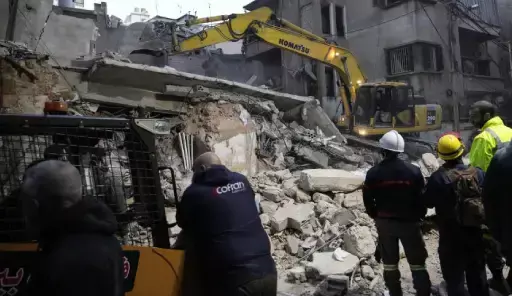Live
- Judge inspects district jail
- KTR calls for debate on electoral bonds
- ACB slaps notice on KTR again
- Bourses bleed on HMP virus scare
- PPA case: Govt wheels moving at slow pace to pin down KCR
- Chandrababu to continue Kuppam your for second day Two-Day Visit to Kuppam Constituency
- TG govt to announce new energy policy on Jan 9
- Class 11 student held for Kumbh Mela bomb threat
- School Games national volleyball tourney begins
- Don’t press panic button: Minister Damodar Raja Narsimha
Just In
What is UNSC Resolution 1701 and How it Relates to the Israel-Lebanon Ceasefire


What is UNSC Resolution 1701 and How it Relates to the Israel-Lebanon Ceasefire
The Israel-Lebanon ceasefire, based on UNSC Resolution 1701, aims to end hostilities, with Hezbollah retreating and Israel withdrawing troops from southern Lebanon.
Israel and Lebanon entered into a ceasefire agreement, effectively ending over a year of hostilities. The ceasefire, brokered by the United States and France, comes after months of escalating tensions, especially along the Blue Line, the de facto border between Israel and Lebanon. This new ceasefire draws heavily from UNSC Resolution 1701, passed in 2006, which aimed to stop the hostilities between Israel and the Lebanese militant group Hezbollah. The ceasefire agreement, which marks a significant moment in current affairs, follows a year-long conflict that intensified after the onset of the Israel-Palestine conflict in October 2023.
What is UNSC Resolution 1701?
UNSC Resolution 1701 was passed on August 11, 2006, after Israel launched a military campaign in Lebanon in response to Hezbollah Israel skirmishes. The resolution called for a full cessation of hostilities, the withdrawal of Israeli forces from southern Lebanon, and the deployment of a UN peacekeeping force (UNIFIL) to monitor the situation. The Blue Line, marking the boundary between Israel and Lebanon, was to be respected, and the resolution demanded that no foreign armed groups, including Hezbollah, operate in southern Lebanon. This was meant to help prevent further Israel-Lebanon violence.
The resolution also included provisions for Hezbollah’s disarmament, a crucial point in ending the conflict. However, many of the terms of Resolution 1701 were not fully implemented, particularly the disarmament of Hezbollah, which remained a powerful force in Lebanon despite the resolution’s mandates. This failure to fully implement the resolution contributed to the recurring instability along the Blue Line.
The Current Ceasefire Proposal and Resolution 1701
The Israel-Lebanon ceasefire reached on November 27, 2024, builds on the framework of Resolution 1701 and aims for a sustainable resolution to the current conflict, which escalated significantly after the Israel war with Hezbollah. Under the new ceasefire, both sides agreed to a cessation of hostilities within 60 days, giving Hezbollah Israel fighters time to retreat 40 kilometers away from the Israel-Lebanon border.
The proposal also requires Israeli ground forces to withdraw from areas of southern Lebanon they have occupied since the escalation in October 2023, when the conflict erupted after months of tension linked to the Israel-Palestine conflict and the broader dynamics of the Israel Gaza situation. The Lebanese government, with support from UNIFIL peacekeepers, is tasked with closely monitoring the movements of Hezbollah and preventing any regrouping south of the Litani River. The monitoring and enforcement mechanisms will also involve a multinational committee to ensure compliance with the terms of the ceasefire.
Monitoring and Enforcement
UN peacekeepers will once again play a central role in monitoring the Israel-Lebanon ceasefire and ensuring the Blue Line is respected. UNIFIL, the United Nations Interim Force in Lebanon, has been authorized to deploy troops along the Blue Line and ensure that Hezbollah does not rearm or reposition in violation of the ceasefire. Additionally, the Lebanese military will assist in these monitoring efforts. Israel has stated it will resume military operations if Hezbollah violates the terms of the agreement or if hostilities resume.
The Broader Context of the Ceasefire
The renewed ceasefire comes at a time of heightened tensions in the region. The conflict between Israel and Lebanon was exacerbated by the broader violence surrounding Israel’s war in Gaza and the subsequent Israel-Palestine conflict, which saw rising casualties and global concern over Israel’s military actions. Skirmishes along the Blue Line had already been increasing as Hezbollah, a Shiite militant group supported by Iran, began firing rockets into Israel in solidarity with Palestinian factions, which further destabilized the situation. This period of violence highlighted the fragile nature of peace in the region and underscored the need for a lasting ceasefire agreement based on Resolution 1701.
Conclusion
The latest Israel-Lebanon ceasefire is rooted in the provisions of UNSC Resolution 1701, which aimed to bring an end to hostilities between Israel and Hezbollah following the 2006 war. While the resolution was never fully implemented at the time, the current ceasefire agreement reflects efforts to bring a permanent solution to the longstanding conflict along the Blue Line. As tensions between Israel and Hezbollah persist, the success of this ceasefire will largely depend on how well the provisions of Resolution 1701 are implemented and monitored by UN peacekeepers, the Lebanese military, and the international community. However, with the ongoing instability in the region due to the Israel war and broader Middle Eastern tensions, it remains to be seen how sustainable this agreement will be.

© 2024 Hyderabad Media House Limited/The Hans India. All rights reserved. Powered by hocalwire.com






